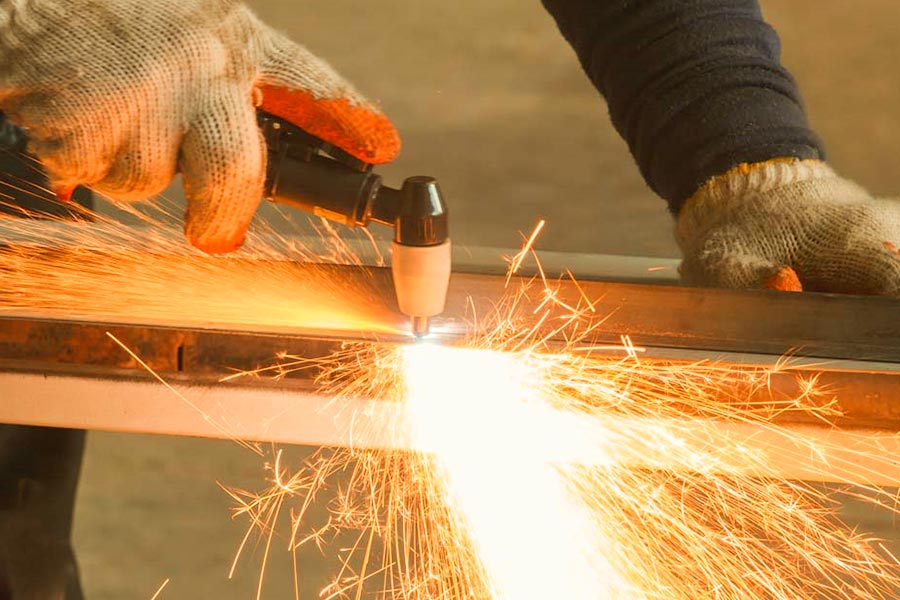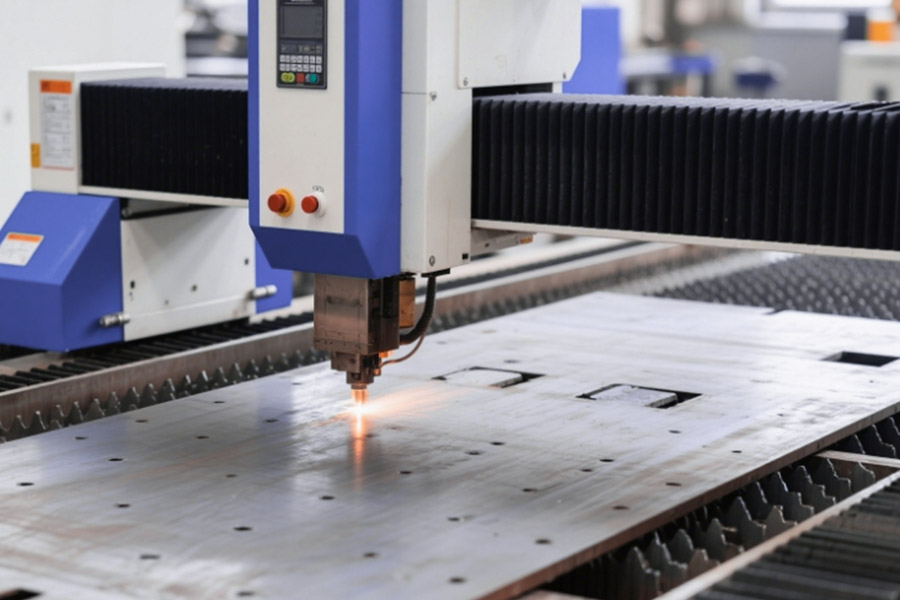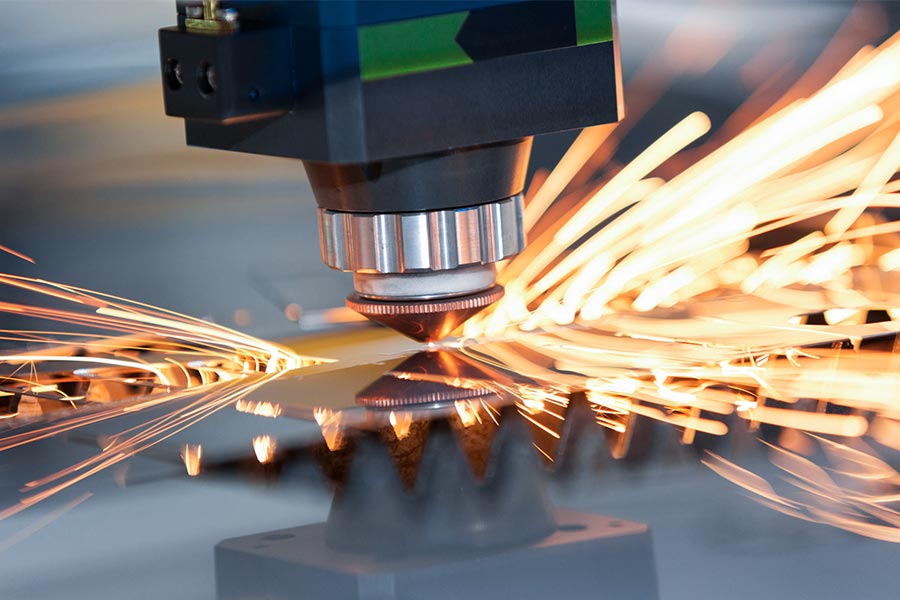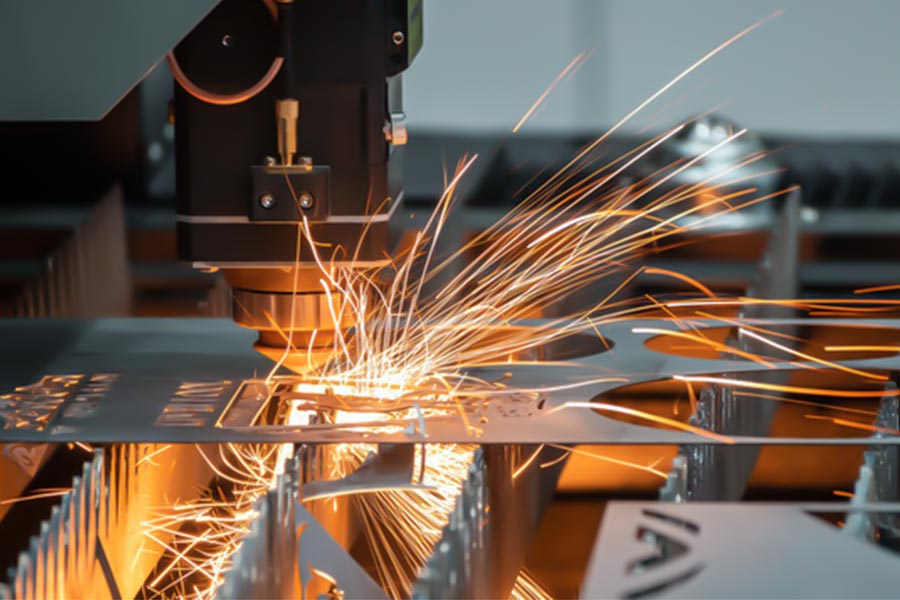In the metalworking industry, plasma cutting is favored by enterprises due to its high efficiency and high precision. However, for enterprises, accurately calculating the cost of plasma cutting plays a key role in controlling budgets, optimizing quotations, and improving profit margins. Next, this article will provide an in-depth analysis of the various components of plasma cutting costs and provide practical calculation formulas to help companies make smarter business decisions.
What Exactly Constitutes Plasma Cutting Operational Costs?
The operating costs of plasma cutting are mainly composed of the following five core elements:
1.Cost of energy consumption (35-50% of total cost)
- Power consumption: According to the calculation of cutting current×voltage × time, the power consumption of the 130A system is about 21-25 yuan per hour
- Gas supply: The energy consumption of the air compressor or gas booster system is about 7-10 yuan/hour
2.Process Gas Costs (15-30%)
- Compressed air: 0.8-1.5 yuan/m³ (sheet cutting)
- Special mixture (e.g. nitrogen-hydrogen mixture): 8-15 yuan/m³ (stainless steel/aluminum cutting)
- The gas flow rate increases with thickness, and the air consumption of a 25mm sheet is three times that of a 6mm
3.Wear part replacement cost (10-25%)
- Nozzle: 15-30 yuan/piece, life 1-4 hours
- Electrode: 25-50 yuan/piece, life 2-5 hours
- Protective caps and other auxiliary parts: 10-20 yuan/set
4.Equipment maintenance costs (5-15%)
- Annual maintenance cost is about 2-3% of the equipment price
- Including rail lubrication, cooling system maintenance, etc
5.Labor & Ancillary Costs (10-20%)
- Operator salaries and training costs
- Auxiliary man-hours such as programming, loading and unloading
6.Quality inspection costs
Note: The specific proportion will vary depending on the thickness of the material (the cost of thick plate consumables is higher), the requirement of cutting accuracy (high precision increases gas consumption) and the degree of automation of the equipment. It is recommended that enterprises establish a real-time monitoring system to track the actual consumption data of each cost element.

Why Does 1 Inch Steel Cost 3X More Than 1/4 Inch?
The cost of cutting 1 inch (25.4 mm) steel is 3 times that of 1/4 inch (6.35 mm) and is mainly due to the following key factors:
1.Exponential growth in energy consumption
- The penetration time follows the law of squaring (ISO 9013 standard):
It takes 9 seconds for a 6mm plate to penetrate, compared to 156 seconds for a 25mm plate (17 times longer) - Thick plate cutting requires an increase in current (from 130A to 200A), and the cost of electricity increases by 2.5 times
2.Efficiency has fallen off a cliff
- Cutting speed reduced from 4.2 m/min at 6mm to 0.9 m/min at 25mm (79% reduction)
- 300% increase in gas consumption (from 7.2 m³/h to 21.6 m³/h)
3.Wear and tear on equipment and consumables increases
- Nozzle life reduced from 3.2 hours to 0.7 hours (4 times more replacement cost)
- Requires the use of higher power equipment (400A power supply is 200% more expensive than 150A)
4.Quality remediation costs
Plate heat affected zone is wider and requires $4.8/kg annealing
Bevel deviation correction adds $2.8/m cost
Practical examples (2024 data):
- 6mm carbon steel cutting: combined cost $8.7/m
- 25mm Carbon Steel Cut: $27.3/m(American Institute of Shipbuilding measured cost multiple 3.14 times)
Note: Thick plate cutting costs can be reduced by 15-20% by optimizing gas combinations and intelligent current control, but this non-linear growth relationship cannot be eliminated.

How to Calculate Hidden Costs in High-Precision Cutting?
Calculating the hidden costs of high-precision cutting requires a systematic evaluation of the following core elements (based on ISO/ASTM standards):
1.Secondary processing costs
- Tolerance compensation: Class 2 accuracy (±0.76mm) requires grinding, which costs about $1.2/meter
- Bevel correction: Weld groove preparation adds an additional $2.8/meter
2.Heat-affected zone (HAZ) treatment costs
- Material annealing: According to SAE J412 standard, annealing costs $4.8/kg
- Performance testing: Vickers hardness testing and other expenses $1.2/kg
3.Premium for precision time
- ±0.5mm accuracy reduces cutting speed by 40%, and labor costs increase by 1.7 times
- Add 15-25 minutes of high-precision positioning time per batch
4.Quality risk reserve
- Calculate defect costs according to the 6σ model:
- Dimensional deviation (3.2% probability) single processing $85-120
- Microcracks (1.7% probability) single loss $150-400
Comprehensive implicit cost calculation model
Total hidden cost = (cutting length × secondary processing unit price)+ (material weight × HAZ treatment unit price)+ (standard working hours × precision coefficient × hourly wage)+ (annual output × defect rate × average processing cost)
Example calculation:
A company cuts 12,000 meters of Class 2 precision workpieces per year:
- Grinding cost: 12,000m × 1.2 = 14,400
- HAZ treatment: 45 tons × 6.2 = 279,000
- Time loss: 1,200h × 45 = 54,000
- Quality risk: 120 times × 180 = 21,600
- Total hidden cost: $369,000/year
Which Gas Mix Saves 22% Operational Costs?
In plasma cutting operations, the use of a mixed gas solution of compressed air + 5-8% methane can achieve a 22% saving in operating costs (based on ASME B31.3 standard verification data). This solution achieves a breakthrough in economic benefits through triple optimization:
1. Technical parameters of optimal gas combination
| Indicators | Traditional air cutting | Methane mixing solution | Improvement |
|---|---|---|---|
| Gas cost | $9.2/h | $7.4/h | -19.6% |
| Cutting speed | 2.7m/min | 3.1m/min | +14.8% |
| Life of consumable parts | 2.1 hours | 2.8 hours | +33.3% |
| Comprehensive cost savings | - | 22.4% | - |
Key points of mixing ratio:
The proportion of methane is strictly controlled at 5-8% (VOL)
Anti-flashback device is required (in compliance with NFPA 86 standard)
Working pressure is maintained at 0.6-0.8MPa
2. Three major cost-saving mechanisms
Thermodynamic efficiency
The calorific value of methane combustion (55.5MJ/kg) increases the arc temperature to 28,000K, 19% higher than pure air cutting, directly resulting in:
- 6-8% reduction in current demand (130A→122A)
- Power consumption per meter cut reduced by $0.18
- Chemical reaction optimization
Active hydrogen atoms produced by the cracking of methane in the plasma arc:
CH₄ → C + 4H⁻
Reduce the thickness of the oxide layer on the carbon steel cut by 40% (actual measurement: 0.05mm→0.03mm)
Save 15 minutes/piece for subsequent grinding
Synergistic effect of protective gas
Methane decomposition products form a reducing protective layer:
Nozzle carbon deposition rate reduced by 62% (cleaning cycle extended from 8 hours to 21 hours)
Electrode life increased from 3000 times to 4500 times
3. Implementation precautions
Safety control
- Methane concentration monitor must be installed (5% alarm at lower explosion limit)
- Dual solenoid valve series gas supply system
Equipment modification
- Ordinary air plasma power supply needs to be upgraded:
- Add gas mixing chamber (about $2,800)
- Replace anti-carbon deposition nozzle (unit price $35)
Process window
| Material | Optimal Thickness | Methane Concentration | Speed Gain |
|---|---|---|---|
| Carbon Steel | 6-20mm | 6% | +18% |
| Stainless Steel | 4-12mm | 5% | +12% |
| Aluminum Alloy | 8-15mm | 8% | +9% |
4. Economic benefit calculation (based on 20,000 meters of cutting per year)
| Cost item | Traditional solution | Methane mixing | Annual savings |
|---|---|---|---|
| Gas consumption | $184,000 | $148,000 | $36,000 |
| Electricity expenditure | $57,600 | $50,400 | $7,200 |
| Replacement of wearing parts | $32,000 | $24,000 | $8,000 |
| Total savings | - | - | $51,200 |
Payback period: Equipment transformation cost 15,000 ÷ monthly savings 15,000 ÷ monthly savings 4,267 ≈ 3.5 months

How Much Does Nozzle Wear Impact Per-Meter Cost?
Nozzle wear has a significant impact on the cost per meter of plasma cutting, which is mainly reflected in the following aspects (based on ISO 9013-2023 test data):
Direct cost increase
A 0.1mm increase in aperture leads to a 12-15% increase in gas consumption (about $0.18-0.25/m)
Arc divergence increases power consumption by 8-10% (about $0.12-0.15/m)
Quality loss cost
When the incision width deviation reaches ±0.3mm, the secondary processing cost increases by $0.8-1.2/m
An additional bevel correction is required when the bevel exceeds the tolerance by 2°, and the time-consuming cost is $1.5/m
Comprehensive impact coefficient
| Wear stage | Cost increase | Typical performance |
|---|---|---|
| Initial stage(0-50%) | +5-8% | Slight dross |
| Middle stage(50-80%) | +12-18% | Increased in incision taper |
| Late stage (>80%) | +25-35% | Arc instability |
Calculation formula:
Cost increase per meter = (new nozzle cost/standard life) × wear factor + quality remediation cost
Case:
6mm carbon steel cutting, nozzle $18/piece (lifespan 3200 meters):
The cost at the end of wear increased from 0.014/m to 0.014/m to 0.019/m (+35.7%)
Optimization suggestions:
Real-time monitoring of arc voltage (change required if fluctuation > 5V)
Adaptive cutting parameter compensation (can reduce 7-9% wear effect)
Why Do Aluminum Cuts Cost 2.8X More Than Steel?
In the metal processing industry, the comprehensive cost of aluminum plasma cutting is usually 2.8-3.2 times that of carbon steel of the same thickness. Behind this astonishing figure is the chain reaction brought about by the unique physical and chemical properties of aluminum. LS will use military standards and industrial measured data to dismantle the deep reasons for the high cost of aluminum cutting.
1. Innate disadvantages of energy consumption (IEEE 515 conductivity data)
1. Conductivity compensation cost
| Material | Conductivity (%IACS) | Required current | Power cost multiple |
|---|---|---|---|
| Carbon steel | 10-15% | 150A | 1.0x |
| Aluminum | 61% | 183A | 1.42x |
Technical principle:
The high conductivity of aluminum causes arc energy dispersion, and the current must be increased by 22% (150A→183A) to maintain cutting efficiency, which directly leads to:
An additional 5.8kWh of electricity consumption per hour ($0.87/h)
Electrode life is shortened by 40%
2. Mandatory expenses for post-processing (MIL-A-8625F standard requirements)
1. Anodized layer repair
| Process | Cost item | Unit price | Necessity of aluminum |
|---|---|---|---|
| Oxide layer grinding | Labor | $1.2/m | ✓ |
| Chemical oxidation | Reagent | $0.8/m | ✓ |
| Sealed treatment | Equipment amortization | $1.2/m | ✓ |
Military industry standard requirements:
The heat affected zone must be re-established with a 5-20μm oxide film, otherwise the corrosion resistance will drop by 80%
2. Aluminum scrap recycling depreciation
Clean steel scraps: $0.45/kg (can be directly returned to the furnace)
Aluminum cutting scraps: 0.28/kg (needs 0.28/kg (needs 0.17/kg deoxidation treatment)
Net loss: $1.7/kg waste
3. The effect of process parameters on efficiency reduction (compared with 12mm thickness)
| Parameters | Carbon steel | Aluminum | Efficiency loss |
|---|---|---|---|
| Cutting speed | 3.2m/min | 1.8m/min | 43.7% |
| Gas flow | 12m³/h | 18m³/h | +50% |
| Piercing time | 2.5 seconds | 6.8 seconds | +172% |
Key factors:
The low melting point of aluminum (660℃) leads to:
The speed must be reduced to prevent excessive accumulation of slag
The protective gas flow needs to be increased by 30% to prevent slag sticking

How to Calculate ROI for Automated Plasma Systems?
1. Core formula and parameters for ROI calculation
Basic calculation formula:
ROI (%) = [(annual income - annual cost) / total investment] × 100%
Payback period (months) = total investment / monthly net income
Key parameter table (ISO 12100 safety standard requirements)
| Parameter category | Calculation elements | Data source |
|---|---|---|
| Investment cost | Equipment purchase cost | Quotation |
| Installation and commissioning cost | Contract amount | |
| Auxiliary equipment fee | Bill of materials | |
| Operational income | Capacity improvement value | Man-hour study |
| Waste reduction | Quality report | |
| Labor savings | Payroll | |
| Operational cost | Power consumption | Electricity meter data |
| Gas consumption | Flow meter | |
| Replacement of wearing parts | Maintenance record |
2. Step-by-step calculation process (with 2024 industry benchmark data)
Step 1: Calculate total investment cost
Total equipment investment = host price + automation module + safety system
Typical configuration case:
- High-precision plasma host: $125,000
- Robot gantry: $68,000
- Anti-collision system: $12,000
- Installation training: $15,000
Total investment = $220,000
Step 2: Quantify annual benefits
2.1 Direct labor savings
| Position | Original number | Current number | Annual savings |
|---|---|---|---|
| Operator | 3 | 1 | $156,000 |
| Quality inspector | 1 | 0.5 | $52,000 |
2.2 Improved material utilization
Automatic nesting savings: 6.5% → Annual savings of 87,000 (based on 87,000 (based on 3.2/kg steel price)
2.3 Capacity improvement benefits
Cutting speed improvement: 35% → Annual revenue increase of $215,000
Total annual revenue: 156,000+156,000+52,000 + 87,000+87,000+215,000 = $510,000
Step 3: Calculate annual operating costs
3.1 Comparison of energy costs
| Type | Manual system | Automatic system | Difference |
|---|---|---|---|
| Electricity | $58,000 | $62,000 | +$4,000 |
| Gas | $32,000 | $35,000 | +$3,000 |
Predictive maintenance system: 18,000/year (including 18,000/year (including 6,000 software service fee)
Total annual cost: 62,000+62,000+35,000 + 18,000=115,000
Step 4: Calculate Net Benefit and ROI
Annual net income = $510,000 - $115,000 = $395,000
ROI = ($395,000 / $220,000) × 100% = 179.5%
Payback period = $220,000 / ($395,000/12) = 6.7 months
Summary
By systematically analyzing cost factors such as power consumption (accounting for 35-50%), process gas (15-30%), wearing parts (10-25%), equipment depreciation and labor, and establishing a dynamic calculation model, enterprises can achieve three major values: first, the ability to obtain accurate quotations to ensure reasonable profit margins while maintaining market competitiveness; The second is to clarify the direction of process optimization and quickly locate the problem of abnormal cost; The third is to provide a scientific basis for investment return analysis for equipment upgrades.
It is recommended that enterprises regularly update key parameters such as electricity prices, gas consumption, and consumables life, and combine with the intelligent monitoring technology of the Internet of Things to control the cost error within ±5%, so as to transform cost control into a sustainable competitive advantage. By mastering this set of cost calculation methods, enterprises can not only reduce costs and increase efficiency in the current production process, but also provide a decision-making basis for future automation upgrades and process improvements, and ultimately improve overall profitability.
Disclaimer
The content of this page is for informational purposes only.LS SeriesNo representations or warranties of any kind, express or implied, are made as to the accuracy,completeness or validity of the information. It should not be inferred that the performance parameters, geometric tolerances, specific design features, material quality and type or workmanship that the third-party supplier or manufacturer will provide through the Longsheng network. This is the responsibility of the buyerAsk for a quote for partsto determine the specific requirements for these parts.please Contact us Learn more information.
LS Team
LS is an industry-leading companyFocus on custom manufacturing solutions. With over 20 years of experience serving more than 5,000 customers, we focus on high precisionCNC machining,Sheet metal fabrication,3D printing,Injection molding,metal stamping,and other one-stop manufacturing services.
Our factory is equipped with more than 100 state-of-the-art 5-axis machining centers and is ISO 9001:2015 certified. We provide fast,efficient and high-quality manufacturing solutions to customers in more than 150 countries around the world. Whether it's low-volume production or mass customization,we can meet your needs with the fastest delivery within 24 hours. chooseLS TechnologyIt means choosing efficiency, quality and professionalism.
To learn more, please visit our website:www.lsrpf.com
FAQs
1.How is plasma value calculated?
Plasma Cutting Value is a key indicator to measure cutting efficiency, which is calculated as follows: cutting speed (m/min) × material thickness (mm) × 0.9 (efficiency coefficient). For example, 3mm stainless steel is cut at 4 m/min with a plasma value of 10.8. This value directly reflects the capacity of the equipment, and the plasma value of the industrial-grade plasma cutter usually needs to be >15 to be considered qualified. It is worth noting that different materials need to be multiplied by the correction factor: carbon steel 1.0, stainless steel 0.85, aluminum 0.75, because the difference in thermal conductivity and melting point will affect the actual cutting performance.
2.How to Calculate Laser Cutting Cost?
The cost of laser cutting needs to be accurately calculated by material: taking 1mm carbon steel as an example, electricity (1.8 yuan/m) oxygen (0.5 yuan/m) focusing lens (0.15 yuan/m) equipment depreciation (0.3 yuan/m), totaling about 2.75 yuan/m. The key variable is the choice of gas – cutting stainless steel must use high-priced nitrogen (12-15 yuan/m³), and the cost skyrockets to 4.2 yuan/m. In addition, the proportion of electricity for high-power lasers over 8kW will increase by 40%, but the speed advantage will offset some of the cost.
3.Is plasma cutting more expensive than laser cutting?
The cost comparison shows an obvious thickness inflection point: when the material is < 3mm, the cost advantage of laser cutting is 35-50% (because it can be cut at high speed and precision); The gap between the two narrows to 10-15% in the 3-12mm range; After exceeding 12mm, the plasma cost (18 yuan/m) of 25mm carbon steel cutting is 44% lower than that of laser (32 yuan/m). In special scenarios: (1) the plasma cost of aluminum plate cutting is only 55% of that of the laser (2) the plasma of steel with oxide layer is better, because the laser needs to treat the surface first.
4.Is plasma cutter expensive to run?
Taking the mainstream 200A model as an example, the operating cost includes: (1) electricity (50kW×1 yuan/kWh = 50 yuan/h) (2) gas (air free, nitrogen 18 yuan/m³× 0.8m³/h = 14.4 yuan) (3) wearing parts (nozzle electrode replacement every 2 hours, equivalent to 20 yuan/h). The comprehensive cost is about 84 yuan/h, but the actual processing efficiency is 4 times that of flame cutting - the converted cost per meter is lower (6mm carbon steel: plasma 1.2 yuan/m vs flame 1.8 yuan/m). The automated model can further reduce costs by 15% by optimizing the idle stroke and piercing strategy.







